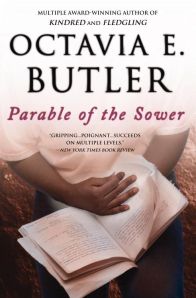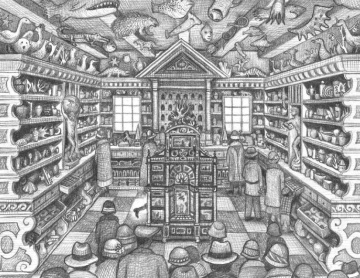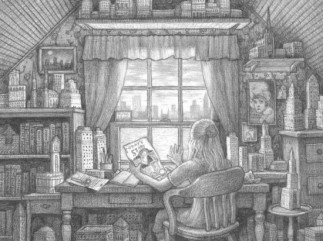 “I tried to look on the bright side, to remind myself that, orphaned or not, I was still better off than most of the kids in Africa. And Asia. And North America, too. I’d always had a roof over my head and more than enough food to eat. And I had the OASIS. My life wasn’t so bad. At least that’s what I kept telling myself, in a vain attempt to stave off the epic loneliness I now felt.
“I tried to look on the bright side, to remind myself that, orphaned or not, I was still better off than most of the kids in Africa. And Asia. And North America, too. I’d always had a roof over my head and more than enough food to eat. And I had the OASIS. My life wasn’t so bad. At least that’s what I kept telling myself, in a vain attempt to stave off the epic loneliness I now felt.
Then the Hunt for Halliday’s Easter egg began. That was what saved me, I think. Suddenly, I’d found something worth doing. A dream worth chasing. For the last five years, the Hunt had given me a goal and a purpose. A quest to fulfill. A reason to get up in the morning. Something to look forward to.
The moment I began searching for the egg, the future no longer seemed so bleak.”
It’s 2044, and the world is out of oil, food, space, and ideas. Reality is bleak and the future is bleaker; the only place Wade can forget about his miserable existence (an overcrowded trailer park outside Oklahoma City) is OASIS, a virtual utopia where he spends most of his time. However, his time in OASIS isn’t aimless; he’s on a mission. OASIS’s creator, James Halliday, was a computer genius obsessed with 80’s pop culture. Of course, the wild success of OASIS made Halliday a multibillionaire, and when he died, it was discovered he had no will. No will, and no heir.
Instead of a will, Halliday left details about The Hunt. Hidden deep inside OASIS was an Easter egg, and the gamer who finds it first wins Halliday’s entire massive fortune. Of course, news of the contest inspires mass chaos and renewed interest in the trends of the 80’s. Wade has dedicated himself to the hunt, pitting himself against a massive corporation in the race to find the egg. There is a lot to lose: Wade has no other hope for his future. Furthermore, should the egg fall into the hands of the professional, corporate hunters, OASIS would undoubtedly be further commercialized and exploited. By collaborating with his friends and sharing resources, Wade sets in this pop-tastic, classic David vs. Goliath narrative.
I’ll admit, I resented any intrusion when I was wrapped up in this book. The USA Today described it as “Willy Wonka meets The Matrix”, and I whole-heartedly agree. Wade’s search takes him inside video games in a way that’s hard to imagine and completely fun to read about it. Even if you miss some of the pop culture references, the book is still engaging; the pressure for Wade to get to the egg before the professional hunters do is believable and keeps you turning pages. Fun? Absolutely?
Matrix”, and I whole-heartedly agree. Wade’s search takes him inside video games in a way that’s hard to imagine and completely fun to read about it. Even if you miss some of the pop culture references, the book is still engaging; the pressure for Wade to get to the egg before the professional hunters do is believable and keeps you turning pages. Fun? Absolutely?
Ready Player One was well-received: a New York Times bestseller, and the recipient of my favorite award-the Alex Award. My roommate read it and when I saw how much he liked it, I couldn’t wait for him to finish it. However, when I was reading, I came across some issues of race and gender that I felt were somewhat problematic, and that affected my feelings about the book as a whole. See, Wade’s closest friend is Aech, a person he thinks is another white male (In OASIS, one can choose an avatar of any race, gender or appearance). Squeezed into a rushed-feeling chapter near the end of the novel, readers discover that Aech is, in fact, a queer African American woman who had been counseled by her mother to adopt the identity of a straight white man. When she reveals this to Wade, rather than discuss the underlying sociocultural structures that led her to conceal her sexual orientation, race, and gender, Wade accepts it without much contemplation, and expresses relief that at least they’d been truthful when, in the past, they’d discussed attractive women.
I felt that Aech’s character was a clumsy attempt at creating a more diverse cast of characters in the novel, but the presentation left me feeling uncomfortable, and wishing the author could have 1. included authentically-presented minority characters, or 2. used Aech’s reluctance to self-identify in a world dominated by Caucasian males as an entry into a discussion of prejudice and inequality. Furthermore, Wade’s reaction to Aech’s queerness, in that he immediately assumed they could bond over discussing beautiful women, felt exploitative. At any rate, it was unsettling.
Ready Player One delighted the video-game-loving part of me, and I was further thrilled by the focus on collaboration over competition, but its treatment of race and sexual orientation left me with mixed feelings about the book. Read it, love the adventure and the imaginative virtual reality interfaces, but I’d advise some thought on what messages the text is sending us about power and those who lack access to it.
Happy Reading!
Author’s website: http://www.ernestcline.com
Cline, Ernest. Ready Player One. Broadway: New York, 2011. 372 pp. Ages 15 and up.
If you liked this book, try another Alex award winner for this year: Robopocalypse. Legend also looks really interesting! However, if you’re looking for dystopias or speculative fiction featuring minority characters in other-than-token-status, it’s still more of a rarity. Here’s hoping for some fantastic, diverse offerings soon!
 “If I found a magic lamp and I could have one wish, I would wish that I had a normal face that no one ever noticed at all. I would wish that I could walk down the street without people seeing me and doing that look-away thing. Here’s what I think: the only reason I’m not ordinary is that one one else sees me that way.”
“If I found a magic lamp and I could have one wish, I would wish that I had a normal face that no one ever noticed at all. I would wish that I could walk down the street without people seeing me and doing that look-away thing. Here’s what I think: the only reason I’m not ordinary is that one one else sees me that way.”









